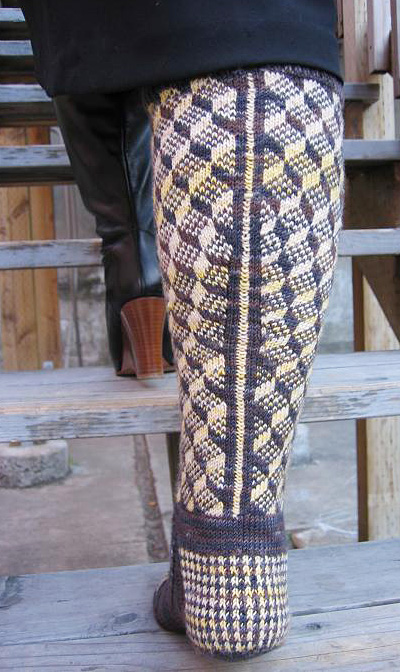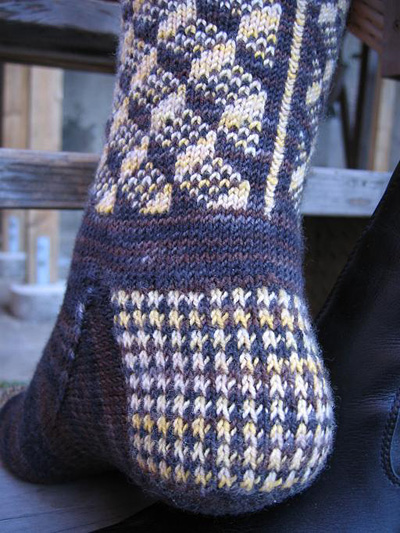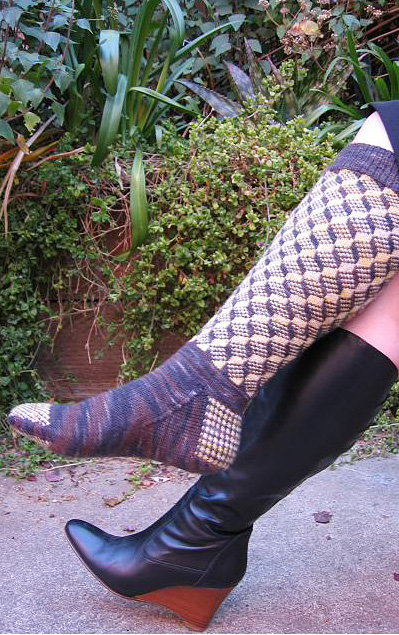  UPPER CALF UPPER CALF
Using MC and circular needle, CO 100[108, 116] sts. Divide evenly between 2 circular needles: 50[54, 58] sts on each needle. Join to begin working in the round, being careful not to twist. Place split ring marker or safety pin in first half of work to indicate Needle 1.
Work in 1x1 Rib until work measures 2 inches.
Increase 1 st at end of last round by working a m1p using CC.
There are 50[54, 58] sts on Needle 1 and 51[55, 59] sts on Needle 2.
Work Rounds 1-14 of Chart A three times. Pattern
repeat will be worked 12[13, 14] times in each round.
SHAPE CALF
Work Rounds 1-42 of Calf Decrease Chart. 69[77, 85] sts. There are 34[38, 42] sts on Needle 1 and 35[39, 43] sts on Needle 2.
Work Rounds 1-14 of Leg Chart three times more.
Work Round 1 once more.
Work measures approx. 14 inches. Break CC.
ANKLE
Ankle is worked using MC only.
Set-up Round: Using double-point needles, k17 onto first needle (Needle 1), k17[21, 25] onto each of next 2 needles (Needles 2 and 3), k18 onto next needle (Needle 4).
Decrease Round: K to end of Needle 1; k1, ssk, k to end of Needle 2; k to last 3 sts on Needle 3, k2tog, k1; k to end of Needle 4.
K 1 round.
Repeat these 2 rounds once more. 65[73, 81] sts.
K2[5, 7] rounds.
Work measures approx. 14.75[15, 15.25] inches.
HEEL
Heel Set-up Round: K to last st on Needle 4, [ssk] with first st on Needle 1; continuing with same needle, k to end of Needle 1 (this needle will now be designated Needle 1). 64 [72, 80] sts. There are 34 sts on Needle 1, and 15[19, 23] sts each on Needles 2 and 3.
Turn work. Heel flap is worked back and forth over the 34 sts on Needle 1.
  Heel Flap: Heel Flap:
Note: The heel flap is worked in a 2-color slip-stitch pattern. Only 1 color is used in each row. When beginning a row with a new color, bring the strand of the new color counter-clockwise around and over the strand of the old color. Consistently changing colors in this way will give a smooth, even edge with no gaps.
Row 1 [WS]: Using CC, [sl 1, p1] to end.
Row 2 [RS]: Using CC, sl 1, k to end.
Row 3 [WS]: Using MC, sl 2, [p1, sl 1] to last 2 sts, p2.
Row 4 [RS]: Using MC, sl 1, k to end.
Repeat these 4 rows 7 times more, then work Rows 1-3 once
more. 35 rows have been worked.
Break CC.
Turn Heel:
Using MC, continue as follows:
Row 1 [RS]: Sl 1, k18, ssk, k1. Turn work.
Row 2 [WS]: Sl 1, p5, p2tog, p1. Turn work.
Row 3 [RS]: Sl 1, k6, ssk, k1. Turn work.
Row 4 [WS]: Sl 1, p7, p2tog, p1. Turn work.
Row 5 [RS]: Sl 1, k8, ssk, k1. Turn work.
Row 6 [WS]: Sl 1, p9, p2tog, p1. Turn work.
Row 7 [RS]: Sl 1, k10, ssk, k1. Turn work.
Row 8 [WS]: Sl 1, p11, p2tog, p1. Turn work.
Row 9 [RS]: Sl 1, k12, ssk, k1. Turn work.
Row 10 [WS]: Sl 1, p13, p2tog, p1. Turn work.
Row 11 [RS]: Sl 1, k14, ssk, k1. Turn work.
Row 12 [WS]: Sl 1, p15, p2tog, p1. Turn work.
Row 13 [RS]: Sl 1, k16, ssk, k1. Turn work.
Row 14 [WS]: Sl 1, p17, p2tog, p1. Turn work. 20 sts remain.
GUSSET
Next Row [RS]: Sl 1, k9; using a new needle
(Needle 1), k remaining 10 sts of heel, pick up and
k 17 sts (1 st in each slipped st) along adjacent edge
of heel flap, pick up and k 1 st in space between top
of flap and sts on next needle; using next 2 needles,
k sts on Needles 2 and 3; using last needle (Needle
4), pick up and k 1 st in space between last st worked
and top of heel flap, pick up and k 17 sts along remaining
edge of heel flap, k first 10 heel sts again. This
point (bottom center of heel) is beginning of round.
86[94, 102] sts. There are 28 sts each on Needles 1
and 4, and 15[19, 23] sts each on Needles 2 and 3.
Decrease Round: K to last 3 sts on Needle 1, k2tog, k1;
k all sts on Needles 2 and 3; k1, ssk, k to end of Needle
4.
Repeat this round 8 times more. 68[76, 84] sts
Work Decrease Round.
K 1 round.
Repeat therse 2 rounds 5 times more. 56[64, 72] sts.
  FOOT FOOT
Sl 1[3, 5] sts from Needle 2 to Needle 1, and from Needle
3 to Needle 4. Each needle now holds 14[16, 18] sts.
Continue in stockinette st until work measures 1.75[2,
2.25] inches less than desired length, ending last round
at end of Needle 3. This point is now beginning of round.
The needle which had been Needle 4 now becomes Needle 1,
Needle 1 becomes Needle 2, etc.
TOE
Work 6[8, 10] rounds following Toe Chart. Chart is worked
twice in each round, with charted decreases worked at beginning
of Needles 1 and 3, and end of Needles 2 and 4.
When all sts have been decreased, 32 sts remain. There
are 8 sts on each needle.
Break CC.
K 1 round using MC.
Slip sts from Needle 2 to Needle 1, and from Needle 3 to
Needle 4.
Graft sts on Needle 1 to sts on Needle 4.
|

